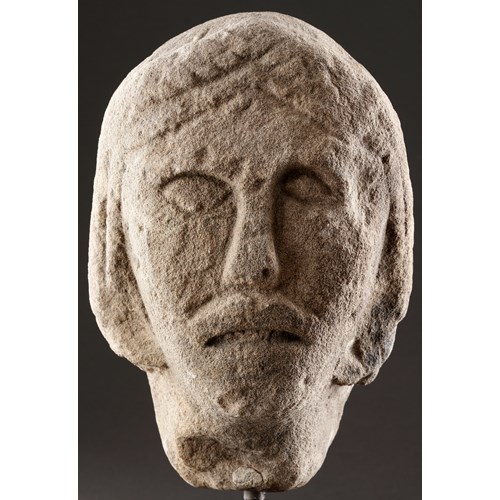A Large and Fine ‘Tiki’ Figure from a House Post ‘Pataka’
Epoque 19th century
Medium Wood, Abalone Shell
Dimension 49 cm (19¹/₄ inches)
The figure carved all over with ‘tattoo’ designs, the eyes inlaid with shell
Wood, halitosis shell (abalone shell)
Maori / New Zealand
19th Century
Size: 49cm high - 19¼ ins high
Epoque: 19th century
Medium: Wood, Abalone Shell
Dimension: 49 cm (19¹/₄ inches)
Provenance: Ex Private collection
Ex Kevin Conru
Ex Private English collection
Literature: The custom of wearing deep facial tattoo, ‘Moko’, had a strong influence on the surface designs of Maori woodcarving. The head was carved as very large in proportion to the body, stressing its symbolic importance, and that it was more ‘tapu’. The powerful expression of the tattooed face evokes the preserved heads of ancestral chiefs. In 1805, John Savage, a surgeon, was in the Bay of Islands. He records tattoo as a class maker: ‘This society is divided into classes, each distinguished by devices variously tattooed on their faces and persons’. (Savage 1807:20) The Maori method of tattooing was painful and of great significance. It was usually carried out in a temporary shelter erected in an area declared ‘tapu’. A variety of chisels were used, often made with elaborately carved bone handles, and having a cutting edge up to a centimetre or more in width. The design was traced and the chisel dipped into a mixture of soot and plant juice. The prepared chisel was then placed in position and the cutting edge driven through the skin with a sharp blow on the back of the instrument. Tattoo designs varied from region to region and represented more than just personal adornment, showing both the lineage, status and military honours of the wearer.
‘Pataka’ were primarily used as food stores, but were also used to safeguard the rare and valued possessions of the Chief. Differing regionally in size and type, they ranked with superior carved houses as the most important structures in a Maori village. The food would be kept inside from the ravages of vermin and from pollution by unauthorised hands. Taboos relating to the possessions and the food of men of high rank were scrupulously maintained with the help of the ‘pataka’ by the whole community. The 19th century artist George French Angas painted a ‘pataka’ at Te Rapa on the shores of Lake Taupo, displaying a small pinnacle figure on the central gable of the small raised structure very similar to this example. He stated that the main use of the storehouse was to give protection to the food especially put aside for chiefs and ‘apart from that eaten by slaves and women’.
These pinnacle Tiki or gable peak figures are best viewed from below at an angle of around 45 degrees. The Maori craftsmen were well aware of this subtle perspective and cleverly worked with the optical requirements of architectural space and form.
Plus d'œuvres d'art de la Galerie









